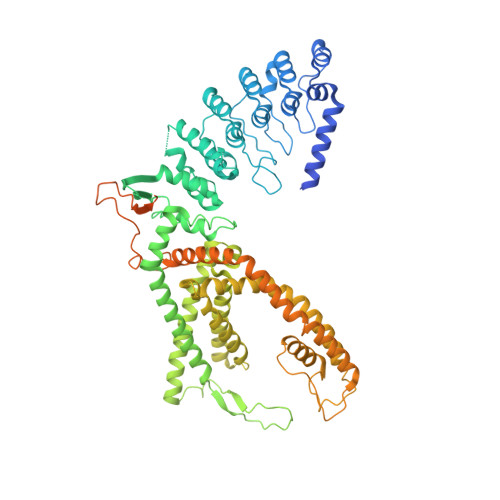Structural basis of TRPV5 regulation by physiological and pathophysiological modulators.
Fluck, E.C., Yazici, A.T., Rohacs, T., Moiseenkova-Bell, V.Y.(2022) Cell Rep 39: 110737-110737
- PubMed: 35476976
- DOI: https://doi.org/10.1016/j.celrep.2022.110737
- Primary Citation of Related Structures:
7T6J, 7T6K, 7T6L, 7T6M, 7T6N, 7T6O, 7T6P, 7T6Q, 7T6R - PubMed Abstract:
Transient receptor potential vanilloid 5 (TRPV5) is a kidney-specific Ca 2+ -selective ion channel that plays a key role in Ca 2+ homeostasis. The basal activity of TRPV5 is balanced through activation by phosphatidylinositol 4,5-bisphosphate (PI(4,5)P 2 ) and inhibition by Ca 2+ -bound calmodulin (CaM). Parathyroid hormone (PTH), the key extrinsic regulator of Ca 2+ homeostasis, increases the activity of TRPV5 via protein kinase A (PKA)-mediated phosphorylation. Metabolic acidosis leads to reduced TRPV5 activity independent of PTH, causing hypercalciuria. Using cryoelectron microscopy (cryo-EM), we show that low pH inhibits TRPV5 by precluding PI(4,5)P 2 activation. We capture intermediate conformations at low pH, revealing a transition from open to closed state. In addition, we demonstrate that PI(4,5)P 2 is the primary modulator of channel gating, yet PKA controls TRPV5 activity by preventing CaM binding and channel inactivation. Our data provide detailed molecular mechanisms for regulation of TRPV5 by two key extrinsic modulators, low pH and PKA.
- Department of Systems Pharmacology and Translational Therapeutics, Perelman School of Medicine, University of Pennsylvania, Philadelphia, PA 19104, USA; Biochemistry and Molecular Biophysics Graduate Group, Perelman School of Medicine, University of Pennsylvania, Philadelphia, PA 19104, USA.
Organizational Affiliation:
















